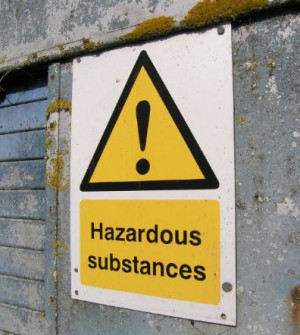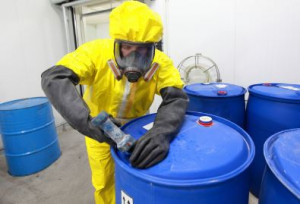A hazardous substance can be defined as any substance with one or more of the following hazardous properties: explosiveness, flammability, oxidising capacity, corrosiveness, toxicity and ecotoxicity.
 These substances can readily explode, burn, oxidise or corrode and/or be toxic to people and ecosystems.
These substances can readily explode, burn, oxidise or corrode and/or be toxic to people and ecosystems.
Everyday products such as paints, cleaners, and batteries can actually pose a hazard to our health and environment. These household items and all commercial or large quantities of hazardous waste and special waste need special handling consideration and must be disposed of safely.
The information in this section is available to download in our information sheet: Hazardous Substances: A Guide for Business Owners [PDF, 925 KB].
Further information
The Council can provide some general HSNO information. If the area is a workplace however, contact the Ministry of Business, Innovation and Employment for more information on HSNO in this area. Their time and advice is free and impartial.
All advice that Council Hazardous Substances Officers give, as well as their time during an inspection, is free. Please contact a Council Hazardous Substances Officer.
The Hazardous Substances and New Organisms Act (HSNO) 1996 has been in force for hazardous substances since 2001. It is administered by the EPA who imposes controls on any approved used of Hazardous Substances. Anyone involved in the handling, sale or servicing of any of these substances must comply with the controls, throughout the life cycle of the substance. As a business owner you are responsible for ensuring that your site complies with the relevant parts of the HSNO legislations including signage and separation distances. A residential customer using LPG for heating will also have to obtain a Location Test Certificate for larger containers greater than 100kg in total. Check out the Environmental Protection Authority (EPA)(external link) website at for further details on hazardous substances How these substances are classified and what controls are needed depends on their properties. Classification is within nine groups: This is to ‘protect the environment, and the health and safety of people and communities, by preventing or managing the adverse affects of Your business premises must have the following: Your responsibility also includes carrying out risk assessment which involves looking at: These rules will ensure your employees and public safety. Awareness of and compliance with the rules is key to preventing incidents when managing hazardous substances. Certification is the responsibility of the employer and is mandatory. Certification helps your workers to better prepare themselves to work safely around hazardous substances. Certification has several important elements: There are other issues which can affect certification, i.e. signage, emergency response, and location certificates. Contact a Test Certifier to determine if a test certificate is required. The Worksafe website has a register of test certifiers(external link) available that you can search for by region or type, e.g. approved handlers, A list of local test certifiers is also available in the Yellow Pages. Test certifiers (the people who certify hazardous substances locations) are privately employed and charge a variety of fees. Non-compliance could lead to issues being raised by insurance companies if you are seeking compensation for incidents, as well as criminal prosecution. It is an offence against the HSNO Act to fail to comply with the requirement to obtain a test certificate as specified in any of the HSNO regulations. Under this Act there are penalties of up to three months imprisonment or a fine not exceeding $500,000 per offence and further ongoing penalties of $50,000 per day the offence is continued.
Classification of hazardous substances
Class
Example
Class 1: Explosives
dynamite, bullets, fireworks
Class 2: Flammable gases
LPG bottles, high pressure cylinders
Class 3: Flammable liquids
Diesel, Gasoline, Kerosene
Class 4: Flammable solids
Magnesium, matches
Class 5: Oxidisers
Hydrogen peroxide, sodium nitrate, nitric acid
Class 6: Toxics
Lead paint
Class 7: Radioactive
(administered by The National Radiation Laboratory)Uranium, Thorium, Plutonium
Class 8: Corrosives
Hydrochloric acid, Caustic soda
Class 9: Ecotoxics
(harmful to the environment or a specific ecosystem)Pesticides
 If hazardous substances are stored at your business, it is important that all rules are followed.
If hazardous substances are stored at your business, it is important that all rules are followed.
hazardous substances and new organisms’, which the EPA states as the purpose of HSNO law.
Types of certification
Approved Handlers
Must be able to demonstrate that they are competent to handle specific substances. Council Hazardous Substances Officers can help you to identify whether you require an approved handlers certificate for your substances.
Approved Fillers
Certification is similar to approved handlers, but is issued to people who fill LPG bottles and other gas bottles.
Location Test Certificates
Is issued for premises where quantities of hazardous substances are stored.
Stationary Container Certificates
Is issued for tanks containing hazardous substances. This certificate is issued once the tank complies with the regulations. One of the most common situations for this certification is diesel tanks.
Getting certified
stationary container systems, etc.Non-compliance
Related news
Design approved for Shirley Community Facility
Plans for a new Community Facility at Shirley Reserve have been approved by the local Community Board.
17 Dec 2025
Fresh start for South Hagley Park waterway
The Addington Brook renewal project has been successfully completed, marking a major step forward for one of the most polluted waterways in Christchurch.
12 Dec 2025
Plans for New Regent St extension
Pedestrian access from one of the Central City’s favourite attractions – New Regent Street – is set to be extended through to the Ōtakaro Avon River promenade.
3 Dec 2025